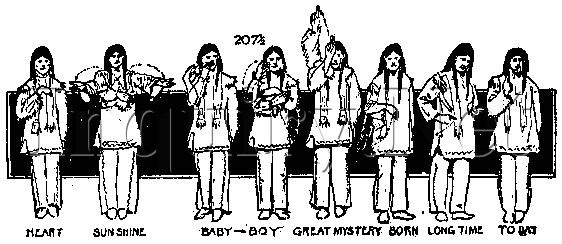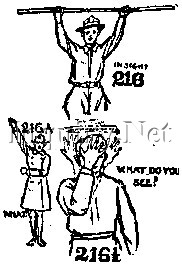By Dan Beard

Fig. 207 1/2. Indian gesture language for Merry Christmas, and is to be read
"Sun shine in the heart a baby boy, Great Mystery, born on this day."
The idea of using gesture signals of the Indian as a universal language among the white people was first suggested by the writer to
the American boys in various magazine articles and his books for boys. Since
then others have taken up the idea and developed it, so in place of writing an exhaustive book on
gesture language, he has tried to select a few gestures for this book which are
in use at the present time and
which, if adopted by us all would make a short and simple system, easily
understood and of practical service.
|
GESTURE SIGNALS USED BY BOY SCOUTS, MILITARY MEN, INDIANS, HUNTERS, COWBOYS, AND POLICEMEN |
|
 |
Fig. 208. Go back! Swing hand and arm around over the head. (Western hunter
and plainsman signal.)
Fig. 208 1/2. Go back! Retreat! Shoot your arm up then swing it down to your side. Keep doing this until order is understood. (Military signal.) |
 |
Fig. 209. Move faster; advance double quick. (Military signal). |
 |
Fig. 210. Attention. Open hand held aloft, arm moved from right to left and left to right (about six inches) a number of times. |
 |
Fig. 211. March--go ahead--advance. (Military signal.)
Fig. 211A. March--go ahead--advance.
|
 |
Fig. 211 1/2. Come along--follow, according to the circumstances when it is used. Not so apt to alarm game as the more vigorous military signal. (Hunters in Africa and America.) |
 |
Fig. 212. Move to my left! Surveyors' signal which, reversed, would mean,
move to my right. That this signal may be seen further, a surveyor sometimes
holds a handkerchief in his hand and sometimes his hat in one hand and his handkerchief in the other. Fig. 212 1/2. Go in this direction! column right! swing your hand from the shoulder across the body to the other side horizontally until the hand and arm is extended full length (Military signal.) |
 |
Fig. 213. You are at the right place--Mark it there--Hold your staff there. Signal used when placing a man in line usually the flagman. (Surveyors' signal.) |
 |
Fig. 214. Stop! Halt! Used by traffic policeman, also means stop, talking; keep quiet. (Orators' and stump speakers' and traffic sign.) |
 |
Fig. 214 1/2. Come here, assemble Raise arm as in stop (Fig.
215) then draw
imaginary circle on an imaginary ceiling over head. (Military.)
Fig. 215. Halt! Used by a lookout, the advanced guard or Scout as a command to his companions. (Hunters' sign.) |
 |
Fig. 216. I can see it--it is in sight--game is in sight--drinking water is in
sight--our friends are in sight--the enemy is in sight. Whatever the Scout is sent
to look for, when he sees it the fact is announced by holding his gun, his,
staff or fishing rod over his head horizontally, grasped by both hands.
(Military and sportsman's sign.)
Fig. 216A. What? (Military signal.) Fig. 216 1/2. Open hand moved from right to left in front of eyes, a question, What see you? (Military sign.) |
 |
Fig. 217. Not in sight. Whenever the advanced Scout is unable to see the object of his search the fact is announced by his holding his Scout staff, his gun, his fishing rod or other similar object upright at full arm's length above his head. (Plainsman's signal.) |
 |
Fig. 218. Caution--Be careful--Advance with care, look out for yourselves. Signal is made by holding the right hand up, the left hand down in a straight line with each other and slowly lowering the right hand and raising the left hand and repeating the motion three times. This may mean that there is a treacherous bog or a dangerous trail of any kind; it may mean dangerous animals, an ugly dog, or a vicious bull. |
 |
Fig. 219. Noting to fear--a friend, all clear. From a universal sign--throw up your hands--used to designate a safe trail or to say you are safe in coming this way, or I am a friend, I will not harm you; as the occasion may require. (Hold-up man's sign.) |
 |
Fig. 220. I have found it. When the party is sent in search of something, usually some object lost, if his search is successful he announces the fact by throwing a handful of dust in the air. (Gypsy, Hunters' and Boy Pioneer sign.) |
 |
Fig. 221. Stoop down--lie down--dismount! Hands and forearm extended in front of the body, hands then quickly moved downward, often accompanied by bending the body as the hands are moved downwards. (Hunters,' woodcrafters' and military signal.) |
 |
Fig. 222. Who are you? Index and second finger of each hand pointing forward and upward, arms sharply brought up to the height of the head with the fingers pointing up. (Western Indian sign or signal.) |
 |
Fig. 223. A Scout. The wolf, to the Indians' minds is the greatest scout among the animals and the gesture sign for a wolf is made by closing the fist with the exception of the first and second fingers; these are spread wide apart to rep present the wolf's ears and the hand is held out about the height of the eyes and then moved forward with an up and down motion as if the animal were loping. The wolf being the scout among animals, the same sign is used for both wolf and Scout. This sign given in reply to the sign "who are you?" would mean "I am a Scout." (Indian sign.) |
 |
Fig. 224. An American--a white man--a "Boston" man. First doubled up thumb on the outside of the fingers, thumb placed over the eyebrow to the left side of the face, then drawn sharply across to the right as shown in the dotted lines in the diagram to indicate a hat brim; this in reply to the question "who are you?" would say, "I am an American--a white man--a Boston man"; among Indians represents a man from the East. |
 |
Fig. 224 A. Me or I. Fig. 224 B. Afraid. Fig. 224 C. You, all of you, any of you. Fig. 224 D. No. No in Military signals is "K" of the semaphore code, while yes is "P" of the semaphore code. Combination Figures 224 A, 224 B, 224 C, and 224 D. Defiance. Me afraid of all of you? No! In other words, I am afraid of no one. (Indian sign language.) |
 |
Fig. 225. This has always been among American boys used as the sign for swimming. It means "come and go a-swimming," "I am going a-swimming," or "are you going swimming?" according to the way in which one uses it. In our first Boy Scouts' Society here in America, known as the Sons of Daniel Boone, before the English Boy Scouts was organized, the same position of the hand was used as a salute, or to indicate a scout; the hand was held up with the palm out, then moved with an up and down motion from the person, the fingers representing the ears of a wolf and the motion the loping action of that animal. The wolf, among Indians, being considered the scouting animal and typical of a Scout. When Baden-Powell, remodeled our American Scout idea to fit the the English boys, he added a third finger to the sign using the three fingers to stand for the three promises in the Scout Oath. |